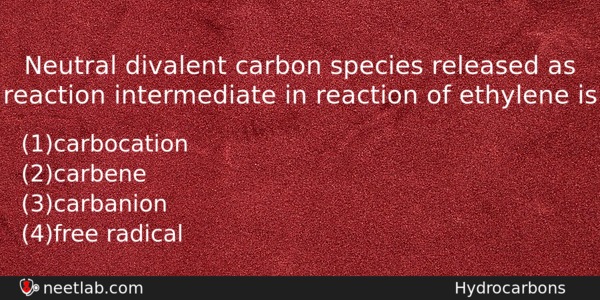| ⇦ | 
| ⇨ |
Neutral divalent carbon species released as reaction intermediate in reaction of ethylene is
Options
(a) carbocation
(b) carbene
(c) carbanion
(d) free radical
Correct Answer:
carbene
Explanation:
Carbocation is the +ve charged carbon species. e.g. ⁺CH₃, ⁺C₂H₅.
Carbanion is the -ve charged carbon species. e.g. ⁻CH₃, ⁻C₂H₅.
Free radical is the trivalent neutral carbon species with an electron. e.g. CH₃, C₂H₅. Carbene is the divalent neutral carbon species with two free electrons. This is two types, such as single and triplet. e.g. :CH₂(triplet), :CH₂(singlet).
Related Questions: - The π-bond organo metallic compound which has ethene as one of its component is
- Which of the following is used to prepare Cl₂ gas at room temperature from
- With oxalic acid, glycerol at 530K gives
- What is the mass of precipitate formed when x mL of solution is mixed with another
- Which of the following is a Lewis acid
Topics: Hydrocarbons
(84)
Subject: Chemistry
(2512)
Important MCQs Based on Medical Entrance Examinations To Improve Your NEET Score
- The π-bond organo metallic compound which has ethene as one of its component is
- Which of the following is used to prepare Cl₂ gas at room temperature from
- With oxalic acid, glycerol at 530K gives
- What is the mass of precipitate formed when x mL of solution is mixed with another
- Which of the following is a Lewis acid
Topics: Hydrocarbons (84)
Subject: Chemistry (2512)
Important MCQs Based on Medical Entrance Examinations To Improve Your NEET Score
18000+ students are using NEETLab to improve their score. What about you?
Solve Previous Year MCQs, Mock Tests, Topicwise Practice Tests, Identify Weak Topics, Formula Flash cards and much more is available in NEETLab Android App to improve your NEET score.
Share this page with your friends

Leave a Reply